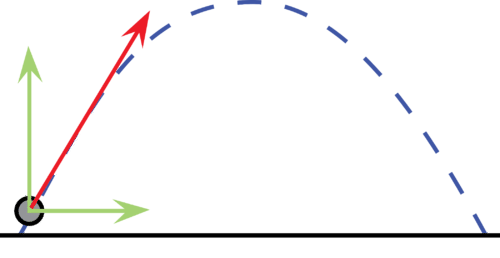READ: Projectile Motion
| Site: | Mountain Heights Academy OER |
| Course: | Physics Q2 |
| Book: | READ: Projectile Motion |
| Printed by: | Guest user |
| Date: | Friday, 1 August 2025, 3:39 AM |
Motion in Two Dimensions
To create this photograph, a camera shutter was opened eighteen times, producing eighteen consecutive images of the snowboarder as he jumped. You can clearly see that there are both vertical and horizontal components to his overall parabolic motion. To complete calculations on this sort of two-dimensional motion, it is necessary to consider the vertical and horizontal vectors separately. By the end of this chapter, you will be able to accurately estimate the time elapsed over the course of this image and between shutter openings, knowing only the maximum vertical height attained by the snowboarder. You will also know how to accurately estimate his maximum vertical height using only the time he spent in the air.
Projectile Motion for an Object Launched Horizontally
The activity of bike jumping, like other sports that involve vector motions in perpendicular directions, requires more physical practice than mathematical analysis. The laws of physics apply to the activity, however, whether the biker is aware of them or not.
Objects that are launched into the air are called projectiles. The path followed by a projectile in motion is called a trajectory. The image of the snowboarder in the chapter introduction showed his trajectory; every object has a trajectory even when we cannot see it. Projectile motion, or the object's trajectory, is described in terms of position, velocity, and acceleration. Even with only an object's current location, velocity, and acceleration, we can calculate when and where the object will land. Our knowledge that perpendicular components of vectors do not affect each other allow us to easily analyze the motion of projectiles.
In the diagram, two balls (one red and one blue) are dropped at the same time. The red ball is released with no horizontal motion and the blue ball is dropped but also given a horizontal velocity of 10 m/s. As the balls fall to the floor, a photograph is taken every second so that in 5 seconds, we have 5 images of the two balls. Each vertical line on the diagram represents 5 m. Since the blue ball has a horizontal velocity of 10 m/s, you will see that for every second, the blue ball has moved horizontally 10 m. That is, in each second, the blue ball has increased its horizontal distance by 10 m. This horizontal motion is due to the ball's constant velocity.
The red ball was dropped straight down with no horizontal velocity and therefore, in each succeeding second, the red ball falls straight down with no horizontal motion. The increasing distances between seconds in the red ball's motion indicates that this motion is accelerating.
A very important point here is that the vertical motion of these two balls is identical. That is, they each fall exactly the same distance vertically in each succeeding second. The constant horizontal velocity of the blue ball has no effect on its accelerated vertical motion. Therefore, the vertical motion of the blue ball can be analyzed exactly the same as the vertical motion of the red ball.
Examples
Example 1
If an arrow is fired from a bow with a perfectly horizontal velocity of 60.0 m/s and the arrow was 2.00 m above the ground when the it was released, how far will the arrow fly horizontally before it strikes the ground?
This problem is solved by determining how long it takes the arrow to fall to the ground in exactly the same manner as if the arrow was dropped with no horizontal velocity. The time required for the arrow to fall to the ground will be the same time that the arrow flies horizontally at 60.0 m/s, so
The time required for the fall is multiplied by the horizontal velocity to get the horizontal distance.
dhorizontal=(vhorizontal)(time)=(60.0 m/s)(0.639 s)=38.3 m
Example 2
A rock was thrown horizontally from a 100.0 m high cliff. It strikes the ground 90.0 m from the base of the cliff. At what speed was it thrown?
We can calculate how long it takes for a rock to free fall 100.0 m and then divide this time into the horizontal distance to get the horizontal velocity.
Projectile Motion for an Object Launched at an Angle
In the case of the human cannonball shown, all the vector and gravitational calculations must be worked out perfectly before the first practice session. With this activity, you cannot afford trial and error – the first miss might be the last trial.
Projectile Motion for an Object Launched at an Angle
When an object is projected from rest at an upward angle, its initial velocity can be resolved into two components. These two components operate independently of each other. The upward velocity undergoes constant downward acceleration which will result in it rising to a highest point and then falling backward to the ground. The horizontal motion is constant velocity motion and undergoes no changes due to gravity.The analysis of the motion involves dealing with the two motions independently.
[Figure2]
Example 1
A cannon ball is fired with an initial velocity of 100. m/s at an angle of 45° above the horizontal. What maximum height will it reach and how far will it fly horizontally?
The first step in the analysis of this motion is to resolve the initial velocity into its vertical and horizontal components.
vi−up=(100. m/s)(sin45∘)=(100. m/s)(0.707)=70.7 m/s
vi−horizontal=(100. m/s)(cos45∘)=(100. m/s)(0.707)=70.7 m/s
We will deal with the vertical motion first. The vertical motion is symmetrical. As the object rises to its highest point and then falls back down, it will travel the same distance in each direction, and take the same amount of time. This is often hard to accept, but the amount of time the object takes to come to a stop at its highest point is the same amount of time it takes to return to where it was launched from. Similarly, the initial velocity upward will be the same magnitude (opposite in direction) as the final velocity when it returns to its original height. There are several ways we could approach the upward motion. We could calculate the time it would take gravity to bring the initial velocity to rest. Or, we could calculate the time it would take gravity to change the initial velocity from +70.7 m/s to -70.0 m/s. Yet another way would be to calculate the time it takes for the object to return to its original height.
If we calculate the time required for the ball to rise up to its highest point and come to rest, the initial velocity is 70.7 m/s and the final velocity is 0 m/s. Since we have called the upward velocity positive, then the acceleration must be negative or -9.80 m/s2
Since this is the time required for the cannon ball to rise up to its highest point and come to rest, then the time required for the entire trip up and down would be double this value, or 14.42 s. The maximum height reached can be calculated by multiplying the time for the upward trip by the average vertical velocity. Since the object's velocity at the top is 0 m/s, the average upward velocity during the trip up is one-half the initial velocity.
The horizontal distance traveled during the flight is calculated by multiplying the total time by the constant horizontal velocity.
Example 2
A golf ball was hit into the air with an initial velocity of 4.47 m/s at an angle of 66° above the horizontal. How high did the ball go and how far did it fly horizontally?




